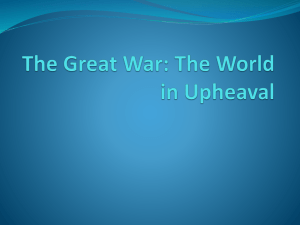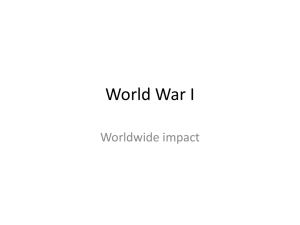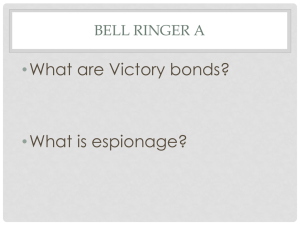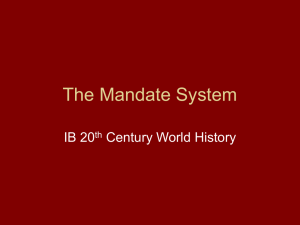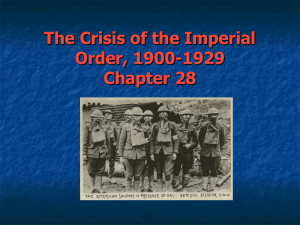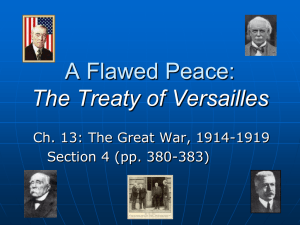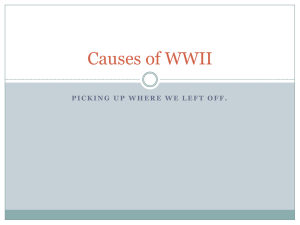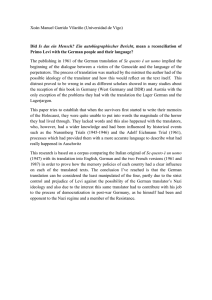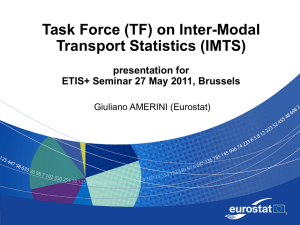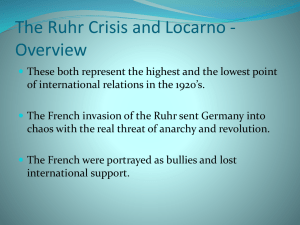Europe and the mandate system
advertisement
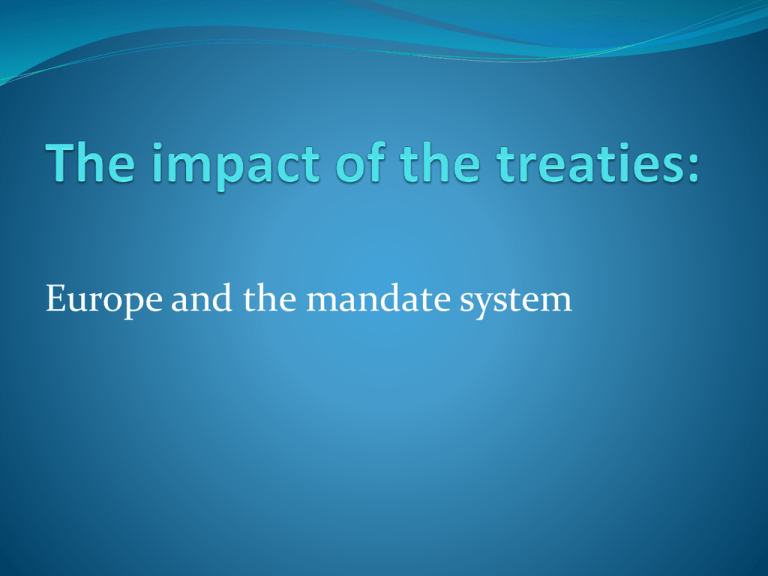
Europe and the mandate system Overview The Treaty of Versailles had an impact on the geo- political and economic situation of Europe. The geo-political impacts were the creation of new states in Central and Eastern Europe and the redrawing of the frontiers of Germany and France. The economic impacts were the weakening of the German economy – territorial loss, reparations and the destruction of the free trade zone in Eastern and Central Europe. Overview contd. In the colonies of the losers, the main impact of Versailles was the establishment of the mandate system. This was an attempt to make imperialism more progressive. The system did not work and it ended up being a poorly disguised way that the winners added territories to their empires. The Impact of WW1 It is very important to understand what geo-political changes the treaties did not make. The Bolshevik Revolution, the political weakening of GB and France, the power of the US, war debts and economic weakness were caused by WWI, not by the treaties. It is easy to confuse what changes were caused by the war and which were caused by the peacemakers at Versailles. Impact of WW1 contd. The war caused the deaths of millions of people; soldiers and civilians who had died of battle wounds, disease, starvation and ethnic conflict. People were shocked in the manner in which these deaths occurred; after four years of war, trenches had not moved more than a few miles. It was a futile orgy of mud and blood which had resolved nothing. Impact contd. This was in stark contrast to the romantic idea of war that had existed in 1914; huge crowds welcomed the war as a chance for glory and adventure. This optimism was soon replaced by a deep pessimism. The number of deaths had left a huge scar. The introduction of new and terrible weapons of mass destruction had created a vision of even more destructive wars in the future. Impact – Fear of War The prospect of another Armageddon-like experience terrified Europeans and caused them to search desperately for alternatives to war. The fear of war was not just physical destruction but the war had also shattered the confidence and optimism of Europeans about their levels of education and progress. How could a society at the peak of human development have allowed itself to engage in so mindless and brutal a conflict? Impact – Political landscape The political landscape had changed drastically with the collapse of the Austro-Hungary, Russian, German and Ottoman empires. There were new countries with new political systems. The monarchy was out; republicanism was in. Most disturbing to Europeans was the fact they had lost the world leadership to the US, whose troops had saved the Allies in 1918 and who now possessed the largest economy in the world. Impact - Revolution Revolutionary ideology had appeared through the Bolshevik Revolution in Russia. The revolution would not have happened without the pressures created by WWI. This was a political and philosophical revolution. It challenged the pillars of western society: religion, property, family, democracy and individualism. It was threatening to engulf Europe in a tide of revolutionary violence and anarchy. Impact –Social Changes Women in Western countries had received the vote and their role in the war would ensure they would continue to demand equal treatment. The war had been a “total war” (pg 13) which had placed great demands on society. It was the first mass media war in which the governments used propaganda to raise the emotional commitment to the war. Impact – harsh treatment Anger, revenge and vilification of the enemy were used to maintain the flow of recruits to the killing fields and to sustain the sacrifices demanded of the civilian population. This near hysterical campaign to support the war had serious consequences. The harsh aspects of the Treaty of Versailles can be attributed to the promises of revenge on the enemy made by politicians during the war. Impact – Post war experiences The experience of WWI led Europeans to believe that that another war would see the end of civilization and any chance to avoid it should be taken. People felt that new ideas and methods to resolve conflicts would have to be found and that humanity should rely on reason rather than strength to resolve disputes and keep the peace. Interdependence and mutual support rather than rivalry and conflict was the only way to avoid another war. This helps to explain the over-optimism of the 1920’s and the reluctance to confront the dictators in the 1930’s; compromise was better than war. Geo-political impacts of the treaties on Europe Ten states were created in Central and Eastern Europe and the Balkans. The Paris Peace Conference set about defining the frontiers of these new countries based on the principle of selfdetermination. This was an extremely difficult problem as various nationalities did not always live in specific areas but were scattered over territories and in many cases mixed with other racial groups. This was because these people had lived in multinational empires in which people had some freedom to move around. Problems The most difficult part of the problem was to create viable states in terms of economics, communications and security. In order to do this these new states should be designed with access to natural resources, trade routes, rivers and oceans. Extending a country’s border to give it access to a trade route might mean incorporating people from another ethnic group. This is a violation of self determination was seen as necessary for economic survival of the state. Solutions? Populations could have been moved but this idea was not practical. The Allies asked that new nations protect the rights of any minorities within their borders. Minority groups could appeal to the L of N which maintained a Minorities Commission. This was a step forward in emphasizing human rights. European stability? The creation of these new states did not help European stability . It created a number of small, vulnerable countries which lacked political or economic stability. The way in which these states were created gave rise to internal tensions and ongoing disputes with neighboring states. The following complicated factors led to the design of these states: ethnic, linguistic, cultural, strategic and historical factors all played a role. The aims of the allies also played a factor in determining the frontiers of the new states. Self- determination This means that a common language and ethnic background should decide the nature of a state. This principle was not adhered to in a number of cases: South Tyrol, the Polish Corridor (pg 35) and the Sudetenland. In many cases it was virtually impossible to separate ethnic groups because they were so intermingled. This meant that over 30 million people ended up as minorities in other countries. (see source on pg 35) Self-determination v Economic/Strategic viability The Allies had to decide which of these two criteria should be most important when designing new states. There was no point to setting up a nation based on ethnicity if it could not survive economically. The hope was that stable and democratic governments would be developed in these countries and a key to this would be economic prosperity. This led to the creation of the Polish Corridor to give Poland access to the Baltic and to make Danzig a free city to maximize trade opportunities. Problems for new states The problems began straight away with the economic situation. Before the war the Austro-Hungarian Empire had been one economic entity. This was replaced by a group of small, unstable, economic units trying to survive by interrupting commerce that had existed for centuries. This could have been addressed at the peace conference as the third of the Fourteen Points supported the removal of trade barriers. Disputes Serious disputes broke out between states which had lost key industries or access to resources. An example would be the dispute between Poland and Czechoslovakia over the Teschen area.(Pg 37) The lack of economic and diplomatic co-operation among the new states made them prone to hostilities with each other. They were also weak and vulnerable and make easy targets for the territorial ambitions of Germany and Russia. Their inability to work with each other to prevent the danger posed by USSR and Germany made their survival doubtful. German empowerment The T of V left Germany resentful, humiliated and angry. Germany lost 12% of her population and 13% of her pre-war territory. Most significant losses were Alsace-Lorraine and the Polish Corridor which divided Germany in two. A further humiliation was that Germans were not permitted to participate in self-determination as Germans in Austria and Czechoslovakia were not allowed to join the Weimar Republic. German empowerment contd. The Germans were determined to revise the treaty at the earliest opportunity. The countries on her eastern frontier were weak and represented a power vacuum which would prove too much of a temptation for Germany when she recovered her strength. The biggest irony of WW1 was that although Germany had lost, she was in a stronger position than she had been before the war started, particularly in the east. The Great Powers that may have restrained her were gone, replaced by a power vacuum. Soviet revisionism An important development not created by the T of V, was the emergence of the Bolshevik regime in Russia. Immediately after the war, Russia was weakened by political revolution and civil war. She had been defeated in a war with Poland and had lost considerable territory as a result. When Russia recovered they would likely target the weak newly created states. The cat and the mice The new states and their relationship with Germany and Russia is very much like the old saying “while the cat’s away, the mice will play.” When the cat returns the mice are in big trouble! The hostility of Germany and Russia towards the new states is seen in their signing of the Treaty of Rapallo in 1922. (Pg 29, 38, 39) The Treaty was designed to undermine the T of V, restore the strength of these two countries and revise the territorial arrangements of Versailles. The Little Entente, 1921 A number of new states knew how vulnerable they were and formed the Little Entente in 1921. (Pg 37) It was an alliance of Czechoslovakia, Yugoslavia and Romania. Its purpose was to protect them from the irredentist claims (Pg 37) of Hungary who was still angry about the territorial losses it had suffered. The LE was a model of military and economic cooperation among its members. Little Entente contd. If it had grown, it may have strengthened the whole region and made it less vulnerable to the revisionist ambitions of Russia and Germany. Rivalry amongst new states prevented this from happening. The alliance was backed by France which was looking for a counter-balance to German power. The loss of Russia as an ally forced France to look for other ways to counter German power. Problems with the LE France made an alliance with Poland in 1921 to discourage German aggression by creating the prospect of a two-front war. Poland was the most powerful of the new states and would have been a vital addition to the LE. Her ongoing dispute with Czechoslovakia over Teschen(Pg 37) made this impossible. When new states were formed and disputes occurred it made it very difficult for them to co-operate for their mutual benefit or protection. Economic impacts The T of V affected the European economic situation more by what it did not do than by what it did. The only economic question that was directly dealt with was that of reparations. Most importantly it did not deal with the issue of Allied war debts. This created bad relations among the debtor nations and the US for many years and added to economic instability as nations struggled to pay off their loans. Ruhr Crisis The debt issue created enormous pressures which led to the Ruhr Crisis in Germany which soured relations between GB and France. The Ruhr was the center of German heavy industry. It was occupied by France and Belgium in 1923 to force Germany to pay reparations. A number of international conferences tried to resolve this issue as a means of alleviating tensions over reparations and assisting in economic recovery. Debt Problems None of these conferences worked as the US refused to cancel the debts of its Allies which weakened their economy and forced them to demand reparations from Germany. Ironically the US offered financial aid to Germany through the Dawes Plan (Pg 39) in the aftermath of the Ruhr Crisis. This crisis may have been avoided if the US had addressed the Allied debt issue earlier. JM Keynes view The economic terms of the T of V were condemned by JM Keynes. He argued that demanding high reparations from Germany along with the losses of territory and resources was foolish! It would hurt Europe and would prevent German recovery. The Allies in punishing Germany were only punishing themselves. Further debt problems The Keynes view has been challenged but it had a lot of support in post-war Europe and helped support the call to revise the T of V. Sympathy developed in GB and the US for German requests to revise the treaty and the reparation payments. This led to a serious split between GB and France over the treatment of Germany. Economic failure! The T of V did not create any effective organization to promote international trade , particularly among the new European states. This failure to develop strong trade links added to the catastrophic impact of the Great Depression of 1929. The establishment and impact of the mandate system. Most people believed that colonial disputes had been a cause of WW1. Wilson addressed this in the 5th of his Fourteen Points. Liberal opinion in Europe and America would not allow the victors to annex the colonies of Germany and the Ottoman Empire. Instead of just splitting the colonies up amongst the victors as spoils of war, the decision was made to create a mandatory system to administer them. Mandate System The territories would be administered by the League of Nations. The mandates were given to countries which had conquered them from the German and Ottomans in accordance with Article 22 of the League Covenant. This says that the purpose of the mandate system was the development of the people in these territories. The League had to ensure that slavery did not take place and that an open door for trade was maintained. The supporters of this system saw it as a way to improve and educate colonies with the goal of them becoming independent democratic states. “A mandates” The territories were divided into three classes of mandate, depending upon how developed and how ready for independence they are. The A mandates were countries who were ready for independence in the very near future. These countries were the former Ottoman states in the Middle East; Lebanon, Syria, Palestine, Transjordan and Iraq. “B Mandates” These countries were much less advanced and had no immediate prospects for independence. These consisted of the German colonies in Africa which were divided between France, Britain and Belgium. See map at the bottom of Pg 41. “C Mandates” These colonies were far less advanced and had no prospects for independence. They were handed directly over to the countries that had conquered them. This meant that German possessions in the pacific were spilt up between Japan, Australia and New Zealand. Southwest Africa was given to South Africa. Devising the mandate system The mandate system was devised at Versailles. The decision on how to split the German territories had already been made before the conference. Documents like the Sykes – Picot Agreement between GB and France had divided the Ottoman Empire between these two powers. Disguised Annexation? The MS seems like thinly disguised annexation. The Japanese annexed and fortified their Pacific Island mandates. This was in clear violation of the terms of the mandate agreement. The impact on the people in the territories was non- existent and they were treated the same way as other colonial populations. Treatment of indigenous peoples Racial equality and progress towards independence were discussed but very little or no time was given to these concepts. It is important to note that for the first time a system of accountability had been set up. The premise was that colonial powers had responsibilities to their subject peoples and that their actions were looked upon by an international body. Controversies Most of the mandates went to GB and France , winners in the war, and already in possession of the world’s largest empires. This angered the Germans who lost everything and the Italians who had received nothing despite being on the winning team! This made the Italians more angry with the Versailles settlement. It also fueled support for Nationalist movements led by Mussolini and contributes to Italy’s desire to gain territory outside of Europe. More Controversy? The Arabs in the Middle East had helped GB to defeat the Ottoman Empire. They had hoped for land and independent status in return for this. The British and French had already decided to divide the area between them according to the Sykes-Picot Agreement. Controversy contd. Their use of the mandate system gave them control of the region after the war – this control was sanctioned by the League of Nations. This infuriated the Arab population and led to a number of uprisings in the post-war period against the British and French. A further controversy, which still has implications today, was the British decision to proceed with the Balfour Declaration of 1917, which gave British support for a national homeland for the Jews in Palestine.
